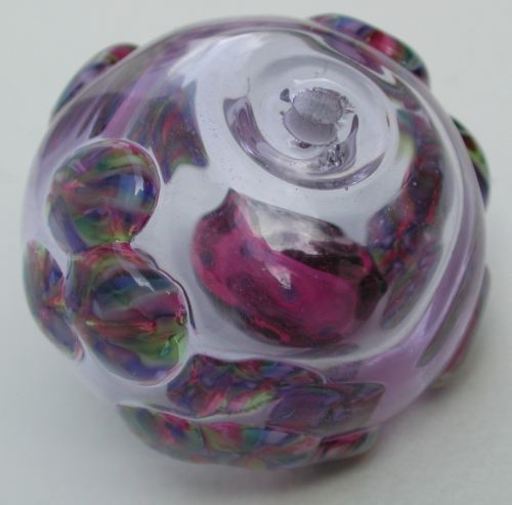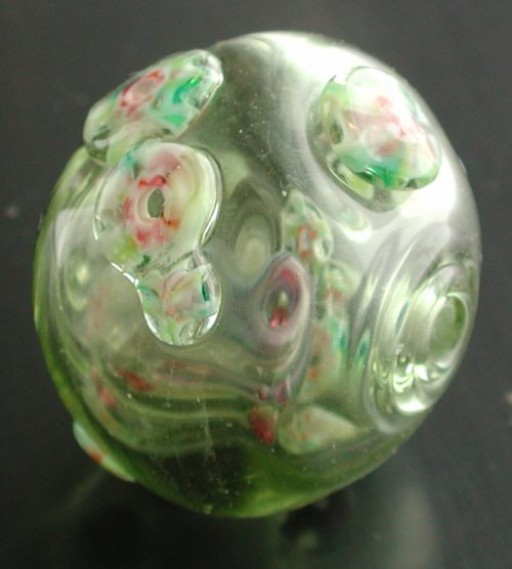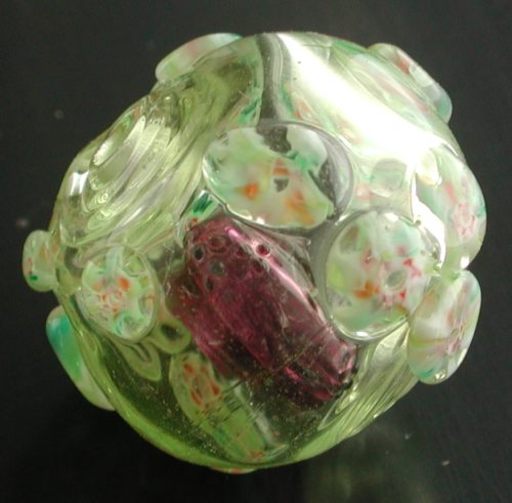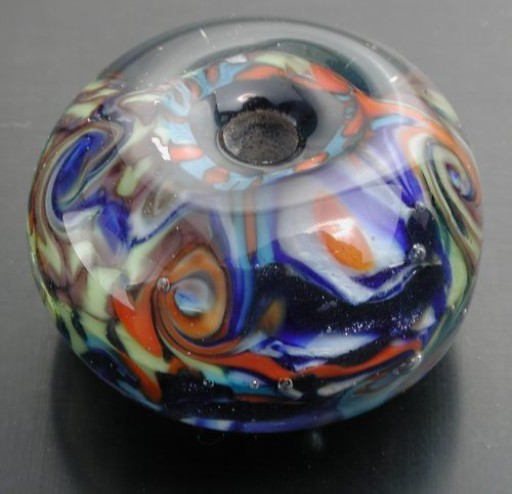Part I: the bead I made (First Iteration)
I have two kaleidoscopes that I've owned for many years; in fact, since before I started making beads 4–5 years ago. One has a number of plastic beads and other items suspended in a clear colorless liquid, and was a gift from a friend who purchased it from the Boston Museum of Art. The other I bought at an art fair, and is of the type that holds a fancy marble, made with ribbon cane. Its colors included white, transparent orange, gold ruby and grass green.
I thought it would be nice if I could make a fancy cane to pick up the patterns I saw, particularly in the artist made kaleidoscope. They're radially symmetrical, of course, along three axes (the point of a kaleidoscope, after all) so I took some periwinkle blue and striped it with purple, green, cobalt blue and gold ruby. My efforts to marver the cane into a triangle more or less went away as I heated the cane and simply attempted to get it to pull evenly. I then cut the cane into three pieces about 2–3” long and attempted to punty them up on a maria, planning to squash them in three triangles so as to get that radial floral type pattern.
At this point my well laid plans began to go awry. As the canes drooped and flopped all over I remembered why people making complex canes don't usually start out with pieces longer than an inch; and my efforts to marver the canes into a hexagon collapsed into one to merely avoid air bubbles. However, I did manage to mash the three canes into one and pull it out; and chop it into murrini. (I really like those Japanese beads with murrini melted randomly into the surface, and they also reminded me of my kaleidoscope's patterns.)
After making the complex cane (complex in that I did two pulls, not that the secrets of the universe are embedded in its patterns), and sprayed pieces of it all over the basement while attempting to cut into murrini, then it was time to make the bead. I thought a double hollow bead, with one bead rolling inside the other, would pick up on the objects rolling around in my first kaleidoscope. I chose czech tourmaline (to pick up on the gold ruby, but still have adequate transparency) for the inner bead. Though tourmaline can be a hard color to strike (for me) in a hollow bead, the inside of another hollow bead is apparently the perfect atmosphere, because they always strike great inside a double hollow.
So after making the inner bead and trailing it with blues and greens, I used alexandrite (because it shifts colors, like a kaleidoscope) for the outer bead. After making this outer bead (which obliged me by not sticking to the inner one, thank you), then it was time to apply the murrini, to give the sense of kaleidoscope patterns sprinkled randomly over the surface.
Now I've watched actual Japanese beadmakers melt their centimeter+ long murrini into beads, yielding beautifully crisp patterns; but it didn't work that way for me—for one thing, surface treatments don't melt into hollow forms the same way they do solid ones (which is sometimes very frustrating for me, trying to imitate solid bead dot techniques). So I did what every other beadmaker in a snit does: mashed and marvered the canes in. All told the double hollow (including making the canes) took something over an hour, but less than two.
Then, of course, I annealed, and had to clean the double hollow. This is the most fun part. I generally put sludge plus on my larger mandrels, and I usually make double hollows on 3/32 mandrels to facilitate cleaning. After wetting and working the double hollow loose and sliding its beads back and forth on the mandrel to loosen and grind as much of the bead release as possible, I waterpikked it thoroughly; put it on a thin (.045in) mandrel and shook out as much of the water as possible. Then I wedged a towel and my hair dryer (which I've never used to dry my hair; when my mother bought for me to take to college in the hopes that I would style my hair or at least dry it, I used it to dry watercolor paintings) into the towel rack, placed the bead (still on the thin mandrel) on top of the wodged towel directly in front of the hair dryer and proceeded to create a racket. Eventually, the moisture, which causes unsightly spots, went away, and the bead was ready to ship.
I can't say the murrini look exactly like the patterns my marble kaleidoscope makes. But at least the three canes do give three axes of symmetry. After seeing other intepretations and getting comments, I should have a better sense of where I want to take this. I hope who ever receives it enjoys it. Though not anything like Ms. Dove's intepretation, it does at least have a lot of colors.
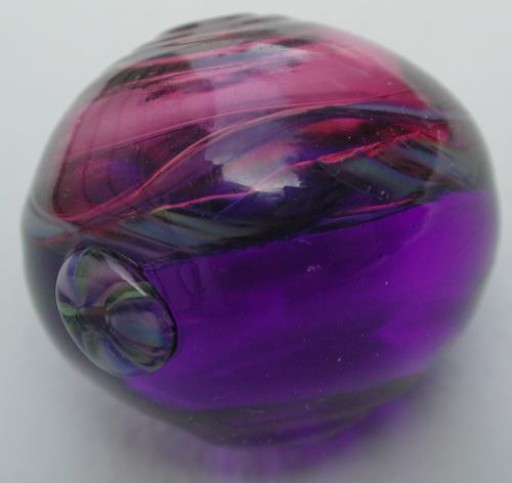
About the smaller bead (a gift to the Exchange co-ordinator): I used a cobalt rod to pull out the complex cane, and of course some was leftover on the end; so I puntied some tourmaline onto that end, and made a hollow bead, making a half sphere till I got to the fancy cane (that is, used up the tourmaline), twisting the cane to make the equator. When I'd laid down all the cane and was down to cobalt, I started the other half of the bead, joining at the cane. Then I applied one of the murrina to it to give it just a bit of a jazz.
Part I, second iteration.
Life is never simple. Although the exchange co-ordinator received the above bead without any problems, when she re-shipped to the ultimate recipient, the rotten thing broken, and all poor Tamara Knight received was a pile of shards. Deanna Griffin Dove informed me of this problem, and I said I would make another one, which I did. In fact, this time I thought it might be nice to make one for myself, so I did that too. And after looking at my marble kaleidoscope again, I decided to try and capture its colors more accurately, and made another, more airy cane with ruby, orange, white, and green. Still considerably chastened from my prior efforts, this was a simple cane.
I liked it, though, and to co-ordinate it better with the base bead, made that in uranium yellow, which (as I vaguely recall) I had in the thicker rods more conducive to making large beads. (Large for me is anything over about 18mm hole to hole.) However, my murrini-application efforts are still dismal, resulting in a mushy mess. Oh, well.
But about the time I finally managed to get the beads done and cleaned out, and line up Ms. Knight's address, which I kept misplacing, we moved. I sent her email explaining the disarray this induced in my life, and there her bead sat. For about 10 months. Finally, having seen it recently enough to remember where it was, and seen a reminder of the letter (I accidentally printed out my list of email, all 2000 of them, instead of a particular letter—easy to do in xemacs if the cursor is in the wrong half of the typically split window) and packing up other orders at the time, I boxed it up with plenty of packing peanuts and sent it out. I also took the co-ordinator's suggestion of threading it with yarn to keep the inside bead from bouncing around, since she theorized that's what caused the problem last time.
And insured the rotten thing so that if it breaks this time, at least I'll get compensated for it.
I chose what I thought was the better bead to send along. The other one, for example, cracked while I was making it, so I had to patch it and to heal it up, which is fine for a personal sample but not something I wanted to send out to someone who'd already received a broken bead. There's a lot more scum in the glass of the one I kept, also.
Part II: the bead I received.
Poor Laura Brito! Hers was the first bead swap in which I participated, and I forgot to send a business card, let alone any notes on the beads I made. Obviously, I more than made up for it this time around.
My bead was made by Amy Smith, of New Creation Designs. The business name is evidently inspired by 2 Corinthians 5:17, for which she obligingly provides the verse, though for curiosity's sake I looked up the Oxford Annotated Bible's (slightly less sexist) rendition: ‘Therefore, if any one is in Christ, he is a new creation [or possibly creature]; the old has passed away, behold, the new has come.’ I was hoping for some interesting Biblico-Historical comments with which I could pad this copy, but all they mention is that in the last two millennia, fragments of Paul's letters to the Corinthians might have been interspersed with each other, what a surprise. But I digress. Here's a shot of the bead:
Get a load of that beautifully dimpled hole—just lovely. The artist notes (in shiny silver ink, no less!) that this bead is “Moretti transp[arent] blue core with lots of twisties, ribbon cane & goldstone added & twisted w[ith] a cold stringer randomly. Encased in Lauscha clear.
“Enjoy!” —which I certainly did, once I managed to get the camera to focus. I was positively ready to tear my hair, until my spouse suggested a) that the mirror I as using to bounce light on the underside of the bead was interfering with the camera's infrared focusing mechanism, and b) that if I would just consult the manual, I could get my focusing indicators to once again display in the LCD (those are little brackets that tell me which part of the image the camera is [theoretically] focusing on). As a bonus, I finally learned how to manually select those areas myself, something I've wanted to do for a long time.
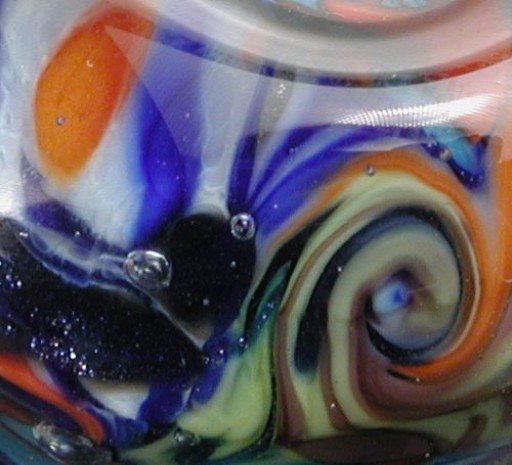
Another view, showing closeup some of the swirling patterns. I was hoping to do justice to the subtleties of the blue goldstone and the patterns, but I'm afraid I've mostly shown up the defiencies of my diffusing materials, instead.
Amy Smith's bead copyright 2002 by Amy Smith/New Creation Designs.
Unless otherwise noted, text, image and objects depicted therein copyright 1996--present sylvus tarn.
Sylvus Tarn